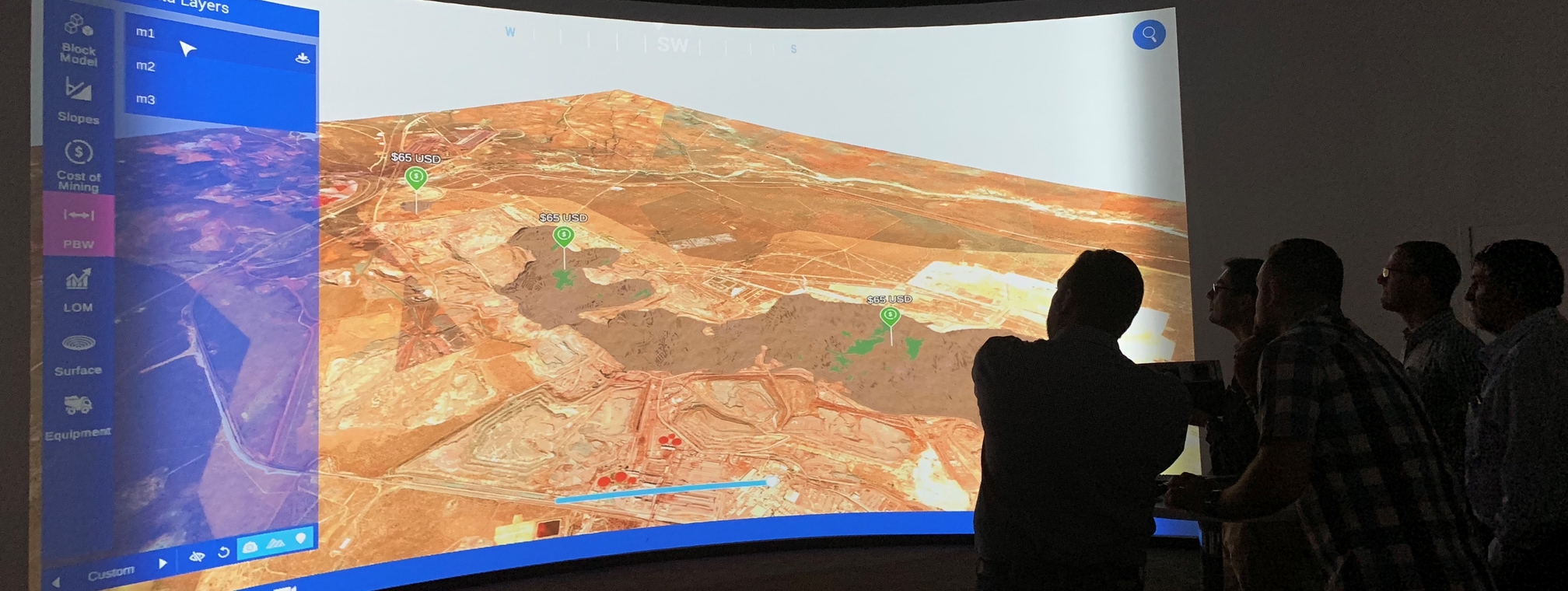How data visualisation is revolutionising mining

Imagine using virtual reality to monitor the performance of your mining fleet in real-time, from the head office. Or, consider the cost-savings and safety benefits of training new haul-truck drivers in an accurate, augmented reality version of the mine where they will eventually be working.
This is not sci-fi or fantasy. In fact, it’s already a reality. And it’s why Maptek has partnered with award-winning big data and virtual reality expert LlamaZOO Interactive to develop data visualisation for mining companies.
We recently discussed how data visualisation is already revolutionising mining with Nick Venter, GM for Maptek’s South African operations, and Charles Lavigne, CEO of LlamaZOO Interactive.
Q: How is the mining industry already taking advantage of AR/VR data visualisation? What’s the impact?
Charles: Mining companies in Canada, Australia and now South Africa are already using data visualisation and VR to speed up the mine planning process and save significant costs. One of our customers used LlamaZOO MineLife to create a “digital twin”, or 1:1 virtual replica, of a planned mine site. As a result they were able to accelerate the project timeline by two years and saved millions of dollars.
The digital twin of the mine site includes data layers of everything— from bore hole, facilities and equipment, infrastructure, pit shells, geology, and even the surrounding landscape such as forest, wildlife populations, and nearby communities. With MineLife VR, the entire site can be explored from a ten-thousand foot view right down to ground level using a VR headset or a desktop PC.
Combining Maptek’s scanning technology, LlamaZOO’s data visualisation capabilities, and cloud networking means anyone can use our tech from anywhere in the world to make faster, better, safer decisions.
With the mine site’s digital twin, created with MineLife VR, our customer transported fewer people to the remote mine site, which saved thousands of dollars while also making the planning and training process much safer.
— Charles Lavigne
Nick: Essentially, a digital twin gives miners an opportunity to simulate different planning scenarios and to see, in a very visual way, the potential impact of each scenario. Just last year, for example, we took mine schedules that had been made in Maptek Evolution by a major coal client of ours, transferred them into VR, and guided our client through the different phases of extraction. Virtual or augmented reality is a very effective means of communicating complex information in a simple, impactful way.
There are four key ways in which our customers have told us that a digital twin could deliver real value to mining operations:
1. Real-Time Mine Data Visualisation
Charles: Resource companies are always focused on significantly saving costs by making their operations more nimble and responsive to market conditions. By pulling in data from a variety of sources, such as telemetry data from haul trucks, SCADA-connected devices like site facilities, and even from individual workers in the pit, it’s possible to create a real-time ‘live’ digital twin that is presented to mine operations via data visualisation.
Fleet management is one particular use case for real-time mine data visualisation. By feeding live fleet data from Maptek partner Minlog into MineLife VR, any manager, from virtually anywhere, can monitor machine health and driver behaviour. By remotely monitoring wear and tear on haul truck tires, one of our Canadian customers saves nearly C$1 million per year at one operation.
Nick: It’s really exciting. With haul truck ‘telemetry’ information, our clients could check meta/performance data, such as speed, and oil pressure for example. Such information could be used to highlight whether certain drivers need training, for instance. Alternatively, it could allow sites to measure the efficiency of haul routes and whether certain parts of the route require repairing.
Going a step further, we can use survey data along the haul route to highlight potential hazards and whether the routes have been built according to specification.
2. Testing and modelling different mining scenarios
Nick: Nowadays, a mining operation is a highly complex ecosystem. Data visualisation such as AR/VR is a really effective tool for bringing mining data to life in order to identify where business performance that can be improved.
Let’s take drill and blast (D&B) as an example.
The D&B process represents one of the biggest cost centres for a mining operation and it has a major impact on downstream processes. As we know, sub-optimal fragmentation can have a negative effect on processing. Incorrect slope angles can affect slope stability, which leads to higher risk.
Today, our customers can already test, measure and optimise the entire blasting process, by using enterprise systems such as BlastLogic. However, AR/VR data visualisation takes it a step further by making it easy to visualise and digest information.
Charles: That’s right. Using OCC 3D (LlamaZOO’s operational command and control solution), mine operators can visualise the drilling process in real time. Information from BlastLogic can be imported into MineLife VR and the blasting process can be simulated to see where possible constraints, inefficiencies and bottlenecks can take place.
Virtual reality is also a powerful tool in the mine planning process. LlamaZOO is currently working with a large iron ore operation in the Cape — we’re assisting them with a research project on how the company can use AR/VR to improve their mine planning. We took different market prices of iron ore and determined the feasibility, based on cost, about extraction based on exploration data.
As mine sites are always changing, and mining companies need efficient ways to monitor and get data, we have partnered with Maptek to help close the loop. For example, Maptek Vulcan helps visualise the data and Maptek Sentry helps analyse slope condition. Thus, creating a more complete picture and enabling continuous improvement.
By making data more accessible in visualisation platforms like MineLife VR, the insights provided by data are more actionable.
3. Presenting greenfield projects
Nick: Our clients see data visualisation as a particularly effective means of presenting information that can often be quite dry, in an immersive, engaging and tangible fashion.
By creating a digital twin of a mining project in VR, we’re making it much easier for investors or government officials to understand the potential impact and value of a project and in a much more tangible way.
Charles: No matter where in the world you’re planning a mine, a significant amount of time and energy is spent on stakeholder engagement. Mining companies have to work not only with governments and regulators, but also with local communities to earn the social licence needed to operate a mine, often over the course of decades. The need to conduct stakeholder engagement can introduce risk and uncertainty into the mine planning process. If a government or host community doesn’t understand how the impact of a mine can be limited, for example, or how future remediation and restoration will occur, it may take years to explain.
It’s also very costly and somewhat risky to fly stakeholders into a remote location where mines are planned. And there are obviously geopolitical risks to consider — mining companies want to keep their people safe.
Having a digital twin means employees and stakeholders don’t have to travel to the physical location of the mine. This is much safer, and much less expensive. By looking at a 1:1 digital twin of the planned mine site, stakeholders can see the proposed operation from every angle, and can get a clear sense of what’s being planned both in the near-term, and decades into the future.
RELATED: See it in action for Galore Creek Mining Corporation.
4. Personnel training and development
Charles: On our tour of mineral producers in South Africa, LlamaZOO learned that a number of innovative mining companies had already begun thinking about the potential for AR/VR in terms of employee training.
For example, training haul truck drivers is an expensive exercise, and not without risk. Shifting training from the mine site to a digital twin visualised in a classroom setting removes the cost as well as safety risks.
Nick: Trainees can learn the job and familiarise themselves with the mine, without actually being there. And, again, this can already be done. We can upload accurate survey/LiDAR data of the mine, captured by survey tools such as Maptek 3D scanners, to create a true representation of the mining environment.
Q: What’s next? How long will it be until data visualisation becomes the norm in the mining industry?
Nick: We feel the time is right for augmented and virtual reality technology to make a big impact in mining. The mining industry is embracing new technology like never before. Maptek and LlamaZOO are working on a number of projects both in Africa and internationally. Some companies are ahead of the curve and have identified how they’re going to use data visualisation in daily operations. They’re investing significant sums to implement the technology. Others are beginning to realise the potential of AR/VR and are in the process of researching how they can best take advantage.
As an example, we were recently approached by a company with underground operations. They want to build a digital twin of their mine in order to identify potential hazards and tunnels in which machines may become obstructed.
Charles: There is huge potential for data visualisation to help mining operations speed up decision making, to improve safety and reduce risk, and to bring more confidence to mine planning. At the same time, I think we’ve only scratched the surface of what the technology can offer, so we’re looking forward to creating more opportunities to engage with the mining industry.
Interested in learning more about virtual or augmented technology? Contact us today and speak to one of our experts.



